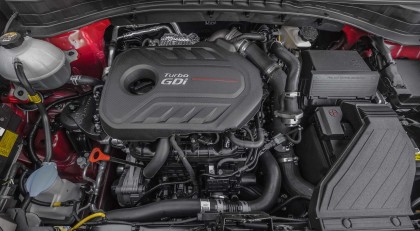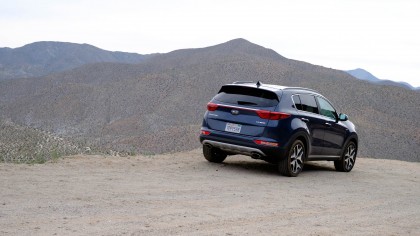Why you can trust TechRadar
Kia offers the Sportage with a standard 2.4-liter four-cylinder motor, but the Sportage SX Turbo is only available with the 2.0-liter turbocharged four-cylinder. Those on the other side of the Atlantic have different engine choices too, like a four-cylinder diesel and a smaller 1.6-liter turbocharged motors.
In North America, the engine is one of the major underlying differences compared to its Hyundai cousin. Kia rates the Sportage SX Turbo motor at 240 horsepower (hp) with 260 pound-feet (lb.-ft.) of torque for front-wheel drive (FWD).
All-wheel drive (AWD) models are rated at a slightly lower 237 hp, due to a different muffler to accommodate the rear driveline. The different muffler design reduces NVH (noise, vibration and harshness). However, a loss of 3hp won't be as noticeable for everyday driving as NVH would be.
A six-speed automatic is paired with all North American Sportage's. There is a difference in gear ratios for the SX Turbo to best take advantage of the 56 extra horses.

While the Sportage SX Turbo offers more power than its corporate cousin, the Hyundai Tucson, it doesn't feel faster at all. But, the 1.6-liter turbo and dual-clutch transmission in the Tucson is more efficient and shifts much faster than the old-school six-speed automatic in the Sportage, so there isn't a feeling of urgency in the Sportage.
Kia's Driver Mode Select (DMS) makes its way into all Sportage models, too. There's normal, sport and eco drive modes. The different drive modes alter the precision and feel of the steering wheel. I prefer the sport mode myself, as the car translates the steering wheel movements to the front wheels with greater precision.
It also feels heavier and requires your whole hand to turn, which is how I like my steering wheel to feel, instead of the feather-light feel that you can turn with your index finger.
Altogether, the powertrain, steering and suspension comes together to provide car-like driving dynamics. It may be a CUV in height, but it feels like a hatchback behind the wheel. The drive route included plenty of windy roads that you can either slow down to a relaxed pace or take it as a challenge to see how well it handles.
I took it as a challenge and pushed it through the twisty roads and came out impressed. The Sportage had minimal body roll and felt planted and confident. I never felt the wheels lose traction or had any "Oh, I'm totally about to drive off into the canyon!" moments.
There was no perceivable handling difference between the FWD and AWD models, but it was sunny and arid outside. I did test the AWD system by playing around in some sand. The system reacts seamlessly and gets the car going with no effort. If you need added peace-of-mind, there's a 4-Lock mode that engages all four wheels without waiting for the front wheels to slip.
Living with it
Since I only spent a full day of driving the Sportage, there isn't much to say about what it's like to live with it. There is one nicety I was able to test: the hands-free smart trunk, or smart power tailgate, as Kia likes to call it.

The feature is simple, if the car is locked when you walk up to the trunk with your key fob in your pocket, it automatically opens the trunk after three seconds. It gives you warning beeps before opening, just in case you didn't want the trunk to open.
It works and doesn't require Kung-Fu kicking action to trigger it. I've yet to encounter any erroneous openings, as the warning beeps are quite loud and you don't have to move too far away from the car to cancel it from opening.
